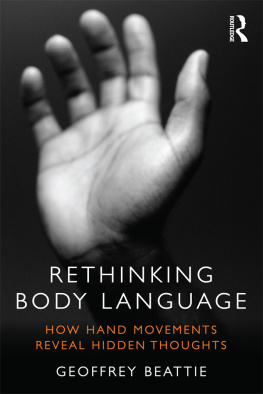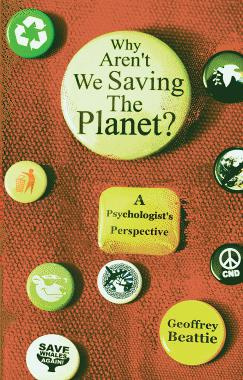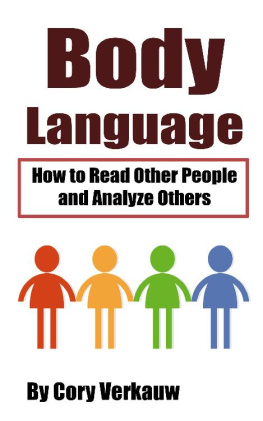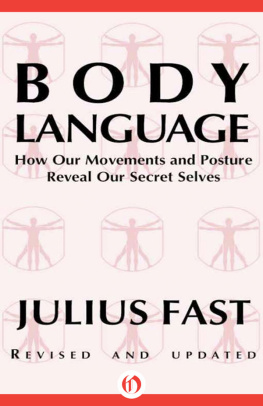RETHINKING BODY LANGUAGE
Challenging all of our old assumptions, Rethinking Body Language builds on the most recent cutting-edge research to offer a new theoretical perspective on this subject that will transform the way we look at other people. In contrast to the traditional view that body language is primarily concerned with the expression of emotions and the negotiation of social relationships, Geoffrey Beattie argues instead that gestures reflect aspects of our thinking but in a different way to verbal language. Critically, the spontaneous hand movements that people make when they talk often communicate a good deal more than they intend.
This ground-breaking book takes body language analysis to a whole new level. Engagingly written by one of the leading experts in the field, it shows how we can detect deception in gesturespeech mismatches and how these unconscious movements can give us real insight into peoples underlying implicit attitudes.
Geoffrey Beattie is Professor of Psychology at Edge Hill University. He is the author of 20 books and over 100 journal articles, and was awarded the Spearman Medal by the BPS in recognition of outstanding published work in psychology. He has presented a number of television programmes and was also the resident on-screen psychologist for 11 series of Big Brother, specialising in body language and social behaviour.
RETHINKING BODY LANGUAGE
__________________________________
How Hand Movements Reveal Hidden Thoughts
Geoffrey Beattie
First published 2016
by Routledge
2 Park Square, Milton Park, Abingdon, Oxon, OX14 4RN
and by Routledge
711 Third Avenue, New York, NY 10017
Routledge is an imprint of the Taylor & Francis Group, an informa business
2016 Routledge
All rights reserved. No part of this book may be reprinted or reproduced or utilised in any form or by any electronic, mechanical, or other means, now known or hereafter invented, including photocopying and recording, or in any information storage or retrieval system, without permission in writing from the publishers.
Trademark notice: Product or corporate names may be trademarks or registered trademarks, and are used only for identification and explanation without intent to infringe.
British Library Cataloguing in Publication Data
A catalogue record for this book is available from the British Library
Library of Congress Cataloging in Publication Data
Beattie, Geoffrey.
Rethinking body language: how hand movements reveal hidden
thoughts / Geoffrey Beattie. 1 Edition.
pages cm
Includes bibliographical references and index.
ISBN 978-0-415-53888-6 (hb) ISBN 978-0-415-53889-3 (softcover)
1. Body language. 2. GesturePsychological aspects. 3. Hand. I. Title.
BF637.N66.B4297 2016
153.69dc23
2015034712
ISBN: 978-0-415-53888-6 (hbk)
ISBN: 978-0-415-53889-3 (pbk)
ISBN: 978-1-315-88018-1 (ebk)
Typeset in Joanna
by Florence Production, Stoodleigh, Devon, UK
This book is a continuation of some ideas which I first developed in Visible Thought, published by Routledge in 2003. Since that time I have continued to actively research this area of how gestures articulate our thoughts alongside speech, and this book describes much of this new, and hopefully exciting, research. The book thus necessarily owes a great deal to my fellow researchers, and the co-authors of the various published empirical papers, and I would like to thank very publicly Brian Butterworth (who supervised my PhD at the University of Cambridge), Rima Aboudan (who did a PhD with me at the University of Sheffield), and Jane Coughlan, Heather Shovelton, Judith Holler, Jamie Ross, Kate Webster, Doron Cohen and Laura Sale (all PhD students, research assistants or research fellows at the University of Manchester). Doron and Laura started off as gesture researchers but became experts in deception! I would also particularly like to thank Laura McGuire (working with me now at Edge Hill University) for everything basically. All of my co-researchers have made very significant contributions to the work I report here. I have tried to tie this body of empirical work together, in order to demonstrate why the spontaneous hand movements generated in talk are so significant.
I would also like to single out a number of academics in particular for special thanks. I have been inspired throughout my academic career by the imaginative and creative thinking of David McNeill, now Emeritus Professor at the University of Chicago, whom I regard as both a mentor and a friend. He is the inspiration behind much of the work I do in this area. I would also like to thank Professor Marcel Danesi from the University of Toronto and Editor of Semiotica. Both of these academics have been incredibly supportive of my work and this support has been invaluable, especially over the past few years. Alan North (to whom this book is dedicated) and Christine Rogers were there when I needed them, and I owe them an extreme debt of gratitude.
I am fortunate now to be working in a great university (Edge Hill) that encourages fresh thinking and allows important ideas to develop and flourish, and I would like to thank the Pro Vice-Chancellor (Research) and Dean of the Faculty of Arts and Sciences, George Talbot, and the Vice Chancellor, John Cater, for their faith in me from the beginning and their constant, unwavering support. I think that I can help make Edge Hill University what it aspires to be.
__________________________________
INTRODUCTION: A NEW PERSPECTIVE ON AN OLD PROBLEM
In this book, I am going to present a new theoretical perspective on bodily communication. It will be very new to the vast majority of people; indeed, it may directly challenge what you think you know about body language. Bodily communication is incredibly significant, indeed more significant than we had ever assumed, but not necessarily in the way that we traditionally imagined. Bodily communication does not just reveal our emotions and how we feel about another person, it reveals our hidden thoughts. In the past few years, new research in psychology has made significant progress in understanding what people do when they communicate to one another, and more importantly exactly how they do it, and this new research challenges many of our long-standing beliefs on this subject. You need to be prepared for a few shocks along the way, to have a few core beliefs shaken. I know enough about human communication to warn you in advance.
I say bodily communication but the focus is really on one important component of bodily communication, namely the movements of the hands and arms that people make when speaking. This might seem overly restrictive but believe me, this in itself is a very large domain of research. I will argue that such movements are not part of some system of communication completely divorced from speech, some system of body language vs verbal language, as many psychologists of the past seem to have assumed; rather these bodily movements are intimately connected with speaking and with thinking. The late Michael Argyle, one of the leading British social psychologists for many years, and the clinical psychologist Peter Trower once wrote that Humans use two quite separate languages, each with its own function (Argyle and Trower 1979: 22). The separate languages they were referring to here were verbal language and body language. According to this view, verbal language, unlike body language, conveys semantic information information about the world, be it our very private inner world (you have caused me so much pain) or the outer world (I was stuck in the house because it was raining, watching the people walk by). It also, of course, conveys ideas and plans, it makes accusations and excuses, insults and compliments, and it cajoles, persuades and disciplines. Body language, they argued, does different things, and is separate from the verbal channel. Body language is the social and emotional channel for conveying emotions and relationships; it signals power, liking, attraction, anxiety and confidence. Of course, it should be immediately obvious that verbal language can do all of these social and emotional things as well; after all, we can simply say I am really down (conveying emotion), Can I see you again? (negotiating relationships), I told you to sit down (signalling power), I really find you fascinating (communicating liking), I love your hair (perhaps indicating attraction, depending upon the context), Im incredibly agitated today (revealing anxiety) or That was so easy (signalling confidence). None of this might be very subtle when it comes to negotiating the intricacies of social relationships or expressing how we feel, but verbal language clearly has a role to play here. However, this new theory argues for the other side of the argument as well; it suggests that hand gesture communicates semantic information (the traditionally accepted domain of verbal language), acting alongside the speech itself. This new theory argues that these movements of the hands and arms reflect our thinking, like language but in a completely different manner, using a different sort of system of communication with very different properties.











